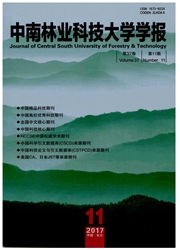

 中文摘要:
中文摘要:
钾(K)是植物生长的必需元素之一,土壤中K含量主要受多种因素的影响。由于森林经营活动和树种组成不同,森林土壤中K含量差异性较大,表现一定的空间异质性。本研究在1hm2石栎-青冈栎常绿阔叶林样地内的10m×10m小样地中心位置,分采集0~10、10~20和20~30cm层的土壤样品,测定土壤中K元素含量,用地统计学理论分析土壤K含量空间变异特征,研究土壤K含量与土壤其它养分元素f有机C、N、P1、地形因子(海拔、凸凹度和坡度)和凋落物量之间的关系。结果表明:0~30cm土壤K含量平均值为28.04g/kg,为中等变异强度,具有明显的空间异质性。除20~30cm土层中K含量符合线性模型外,0~10\10~20土层和0~30cm土层K含量符合球状模型分布,各土层土壤K含量具有较强的空间自相关性。0~10、10~20、20~30cm和0~30cm土层中K含量的空间自相关变程范围分别为37.51、25.38、39.78和28.92m,土壤K含量有较小的空间异质性尺度。各土层K含量随地形的变化趋势较为明显,表现为斑块状空间分布,低值出现在中下部的山脊,高值出现在上部山脊和西南角的部分沟谷。土壤K含量与海拔高度、土壤粘粒含量呈显著的正相关,K含量的空间异质性主要受成土母质和地形等结构因素影响。
 英文摘要:
英文摘要:
Potassium (K) is one of the essential nutrient elements that support plant growth. Soil K concentration could be strongly influenced by many factors in forest ecosystems. Thus, forest soil K concentration showed spatial heterogeneity due to different historical management and tree species composition. In this study, soil samples at 0 - 10,10 - 20 and 20 - 30 cm depth were collect at center in 10 m × 10 m subplot in a Lithocarpus glaber-Cyclobalanopsis glauca evergreen broadleaved forest. Based on geostatistics theory and spatial analysis functions, spatial heterogeneity of soil K concentration in the forest was investigated by using semivariogram of geostatistics. The results showed that the average K concentration of soils at 0 - 30 cm depth was 28.04g.kg-1 and coefficient variability was at the intermediate range with an obviously spatial heterogeneity. While linear variogram function was best fitted to soil K concentration at 20 - 30cm depth, spherical variogram model was best fitted to soil K concentration at 0 - 10, 10 - 20 and 0 - 30cm depths, indicating a strong spatial dependency. The spatial correlation distances (range) of K concentrations were 37.51 m for soil of 0 - 10 depth, 25.38m for soil of 10 - 20cm depth, 39.78m for soil of 20 - 30cm depth, and for soil of 0 - 30 cm depth. Soil K concentrations across all layer exhibited a clear patch distribution pattern, with the lowest values at the middle and lower ridge, and the highest values at upper and southwestern comer. Soil K concentration was significantly correlated with altitude and soil clay content, implying that soil spatial heterogeneity could be attributed to pattern material and topographical factors.
 同期刊论文项目
同期刊论文项目
 同项目期刊论文
同项目期刊论文
 Differences in fine root traits between early and late successional tree species in a Chinese subtro
Differences in fine root traits between early and late successional tree species in a Chinese subtro Tree species effects on ?ne root decomposition and nitrogen release in subtropical forests in southe
Tree species effects on ?ne root decomposition and nitrogen release in subtropical forests in southe Standing fine root mass and production in four Chinese subtropical forests along a succession and sp
Standing fine root mass and production in four Chinese subtropical forests along a succession and sp Soil N forms and gross transformation rates in Chinese subtropical forests dominated by different tr
Soil N forms and gross transformation rates in Chinese subtropical forests dominated by different tr Effects of topographic and soil factors on woody species assembly in a Chinese subtropical evergreen
Effects of topographic and soil factors on woody species assembly in a Chinese subtropical evergreen A molecular method to identify species of fine rootsand to predict the proportion of a species in mi
A molecular method to identify species of fine rootsand to predict the proportion of a species in mi Prediction of tree species composition in fine root mixed samples using near-infrared reflectance sp
Prediction of tree species composition in fine root mixed samples using near-infrared reflectance sp 期刊信息
期刊信息
